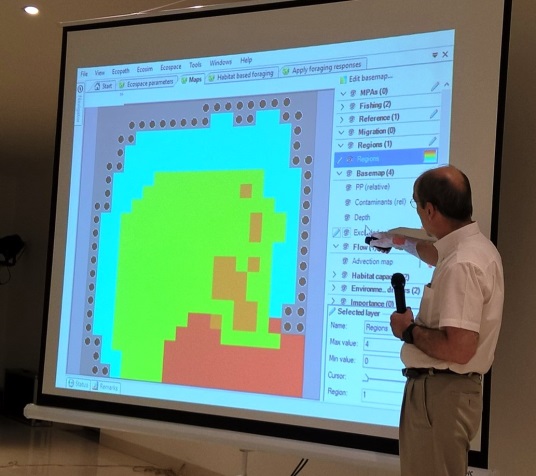08 May, 2017
The CMPA Project organized a 5-day training course on Ecosystem-based Fisheries Management using “Ecopath with Ecosim (EwE)”.
Ecopath with Ecosim (EwE) is an ecosystem modelling software suite, which was initially started at the National Oceanic and Atmospheric Administration (NOAA), but has since primarily been developed at the Fisheries Centre of the University of British Columbia (UBC), Canada. In 2007, it was named as one of the ten biggest scientific breakthroughs in NOAA’s 200-year history, as it had helped to “revolutionize scientists’ ability worldwide to understand complex marine ecosystems”. EwE is a product of three decades of development work in association with Villy Christensen, Carl Walters, Daniel Pauly, and other fisheries scientists. There are more than 6000 registered users in some 150 countries. Their feedback contributes to the further development of EwE.

Participants of the training course
The EwE course was conducted by Prof. Villy Christensen, UBC. The objective was to introduce both researchers and managers in the Indian fisheries sector to a useful tool to create robust models of marine ecosystems and evaluate options for the management of its fisheries resources, both in time and space.
The 15 participants came from a range of Indian research institutions dealing with issues related to fisheries management, including the Central Marine Fisheries Research Institute, Central Inland Fisheries Research Institute and the National Centre for Sustainable Coastal Management. Also present was senior staff from the fisheries departments of Goa and Maharashtra.
Using a fictitious data set, participants were able to familiarize themselves with the approach to modelling a marine ecosystem and to explore some of the key features of EwE. These ranged from more traditional fisheries stock assessment tools such as Maximum Sustainable Yield (MSY) to extremely powerful routines allowing to simulate the effects of protected areas on the biomass and distribution of fish species. A presentation by Prof. Christensen on the large number of cases where EwE had been used worldwide (e. g. in environmental impact assessment) provided the participants with good examples of where to apply EwE in their own area of research.

Prof. Christensen in discussion with managers from the Goa Fisheries Department

Dr. Feroz Khan, Principal Scientist, CIFRI
.jpg)
Mr. Prakash Virkar, Commissioner of Fisheries (Marine), Maharashtra

Use of EwE to assess a fishery according to the MSY concept

An example of the use of EwE to assess employment generated in the fishing sector

Simulation of the effects of a marine protected area
© 2014 IGBP. All Rights Reserved.
Site By: Virtualpages
